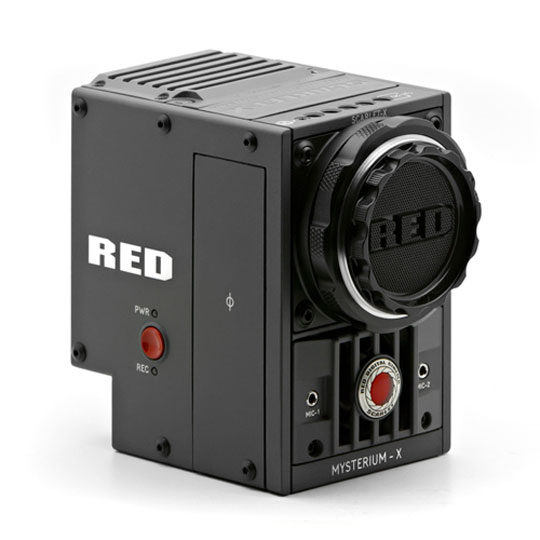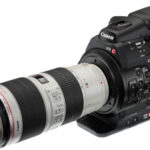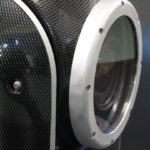
Scarlet-X: An Epic Release?
Posted on Nov 22, 2011 by Alex Fice
The new Scarlet-X, now seen as a ‘de-tuned’ EpicTechnophobes rejoiced this month with not one but two large announcements from Red Digital Cinema and Canon.
Jim Jannard waltzed out to speak to the gathered crowd at Red Studios in Hollywood following much ado about nothing for over 30 minutes in complete darkness – a result, we were told, due to the REDUSER site crashing the company’s servers (apparently over 250,000 people were attempting to access the RED forums at the same time).
Presentation hitches aside, the big news of the evening was a completely remodeled Scarlet with 5K photo / 4K motion capabilities. The camera was then unveiled, an almost identical model to the Epic with slight variations (such as its dark Battleship grey color and smoother exterior design).
Jannard went on to explain how some sensors designed for the Epic camera don’t quite meet threshold requirements to perform such tasks as HDRx. “We realized the Scarlet could use these sensors if the camera had a much lower yield,” explains Jannard.
“With no need to sustain the same data expectations as the Epic it was amazing how quickly Scarlet transformed from a 2/3” 3K camera to a full frame S-35 4K motion camera. She is Epic’s little sister – but with less data rate than her.”
As an overview, here’s what Red announced. Scarlet is a 5K resolution camera available with either Canon EF or PL mounts (Shrewd business savvy from Jannard to capitalize on Canon optics in the camera bags of 5D and 7D shooters).
Scarlet is capable of still bursts of up to 12fps at 5K, 1-25fps at 4K and 60fps at 2K. Additional HDR-x technology is also included (although using HDR-x effectively lowers Scarlet’s aforementioned frame rates in half, but Jannard did outline that Red were working on a solution).
Starting price for the Scarlet-X brain with 5K stills / 4K motion, brain, side SSD and Canon aluminum mount is $9750 (or $11,250 for a Scarlet titanium EF or titanium PL mount).
A full Scarlet Aluminum Canon Mount Package is priced at $14,015. The PL-mount Scarlet was available November 17th – while Canon’s EF mount would be ready to roll by December 1st.
Meanwhile, a few hours earlier, a highly secretive shindig in the Paramount back lot unveiled Canon’s new C300 Cinema EOS camera – a Canon event graced with filmmakers such as Ron Howard and Martin Scorsese who waxed philosophical on film and digital technology.
In short, the biggest glaring differences between Canon’s flagship C300 and Red’s Scarlet are their respective data rates. The C300’s hits a maximum data rate of 50 Mbits/sec to create a 1080p image, while Scarlet pushes 50MBytes/sec to create up to a 5K image – that’s 440 Bytes a second, or over eight times the rate of the new Canon body. Scarlet also records data directly onto SSD cards while the C300 relies on much slower CF card technology to record its 8-bit MPEG-2.
Further, Canon’s C300 uses an 8MP sensor with a total resolution of 3840×2160 (4K HD). Scarlet uses a 14MP sensor with a total resolution 5120×2700 (5K) on a larger sensor. Keep in mind Scarlet’s higher resolution fires short bursts of 12fps, while lower resolutions such as 4096×2167 achieve 25fps. At the same 4K HD setting at the C300, the Scarlet captures 30fps.
Note, however, that overcranking on the Scarlet is only at windowed resolutions. As frames per second are gained, resolving power is lost – and the ability to garner shallow depth of field, a creative Glasnost to many professionals.
Your lenses effectively become longer, more telephoto as the frame rates go up. Looking at the Canon C300 it’s a different story. Sure, you will drop down to 720p resolution for frame rate between 30 and 60, but the camera is downsampling rather than cropping the sensor. This allows lenses to behave the same way.
Esthetically speaking, C300 footage shown at the Canon event was said to be extremely beautiful. I did not attend the event, but I did witness pristine Scarlet footage at the Red Studios. Seemingly both events screened images with much praise from the gathered crowds.
Interestingly, Canon and Red will soon announce a new round of technological battle. Red’s hotly anticipated Dragon Sensor is still in development, as is a 4K DSL from Canon.
The Dragon Sensor is rumored to be a full-frame, 6K offering with the ability to capture true anamorphic with no sensor cropping. As of now this is merely a rumor. Meanwhile, Canon has much to prove with 4K DSLR camera – especially with Scarlet hungry for pristine Canon glass now widespread with the popularity of the 5D and 7D series.
Furthermore, Canon’s close ties to Hollywood and its development of primo 4K EF Cinema Lenses assumes a big commitment to digital cinema. Its upcoming entry into 4K territory will be interesting to see – and possibly nail biting for canon execs; if the new 4K DSLR does not deliver, expect a Canon lens shift to Scarlet-X of Epic proportions.
Simon Wakelin








